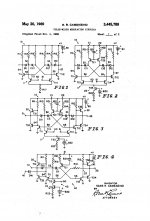Hi all,
I've been interested in class D for a while now and have been wondering how simple they can get. Simple in terms of discrete transistor count, no ICs.
This lead me to various differential pair circuits like comparators and astable multivibrators. Following that trail took me to some old patents such as this: US3445788A - Pulse-width modulation circuits
- Google Patents
I know part of the motivation and benefit of the UcD is a low discrete parts count. An astable multivibrator with variable duty cycle appears at first glance to fit the bill, but they obviously have some fatal flaw, otherwise they'd be common - that patent was filed in 1966. I'm sure the short answer is poor sound quality.
Can anyone explain some of the technical disadvantages?
Thanks!
I've been interested in class D for a while now and have been wondering how simple they can get. Simple in terms of discrete transistor count, no ICs.
This lead me to various differential pair circuits like comparators and astable multivibrators. Following that trail took me to some old patents such as this: US3445788A - Pulse-width modulation circuits
- Google Patents
I know part of the motivation and benefit of the UcD is a low discrete parts count. An astable multivibrator with variable duty cycle appears at first glance to fit the bill, but they obviously have some fatal flaw, otherwise they'd be common - that patent was filed in 1966. I'm sure the short answer is poor sound quality.
Can anyone explain some of the technical disadvantages?
Thanks!
Attachments
Very poor jitter performance I suspect, time-domain jitter translates to noise in the output after filtering.
Please take into account that I have never made a class D amplifier from anything but complete monolithic class D chips.
My first guess is insufficient linearity to todays standards. The patent is mentioning linearity but not to which level as far as I have noticed.
A modulator that translates an input voltage into a PWM signal with an average voltage having more than 0.05% deviation from ideal linearity has no future in audio (my impression). Will that astable multivibrator do better than 0.05% linearity?
With integrated circuits, "simple" is of little importance. The TPA3116 chip is very sophisticated inside but when sold at a very attractive (low) price it can out-compete anything much simpler. Why aim to build a simple class D amp if you cannot sell it?
Last, the UcD concept (not my specialty either). Genius in its simple conception but why not used at low power? It is very simple when you already have a discrete push-pull power stage with a driver circuit, thus that you are designing for higher power levels. Then, you only need to add a few elements and you have a well performing power amplifier such as for PA purposes. The UcD people have achieved wonders in making it linear as well. But, what if you need only 10-50W? All I have seen for that power level is not UcD. Thus, my impression is that UcD is not a general solution, neither will an astable multi-vibrator solution be.
My first guess is insufficient linearity to todays standards. The patent is mentioning linearity but not to which level as far as I have noticed.
A modulator that translates an input voltage into a PWM signal with an average voltage having more than 0.05% deviation from ideal linearity has no future in audio (my impression). Will that astable multivibrator do better than 0.05% linearity?
With integrated circuits, "simple" is of little importance. The TPA3116 chip is very sophisticated inside but when sold at a very attractive (low) price it can out-compete anything much simpler. Why aim to build a simple class D amp if you cannot sell it?
Last, the UcD concept (not my specialty either). Genius in its simple conception but why not used at low power? It is very simple when you already have a discrete push-pull power stage with a driver circuit, thus that you are designing for higher power levels. Then, you only need to add a few elements and you have a well performing power amplifier such as for PA purposes. The UcD people have achieved wonders in making it linear as well. But, what if you need only 10-50W? All I have seen for that power level is not UcD. Thus, my impression is that UcD is not a general solution, neither will an astable multi-vibrator solution be.
Last edited:
Thanks for the responses.
FauxFrench - you make some good points about the marketplace, but I can't draw any specific technical limitations of an asmv from it.
Mark,
I was wondering about frequency stability and my first round of searches didn't turn up much info. I later found a few articles showing how to add a trigger pulse if you need better consistency - so I infer that stability with these may not be that great.
That said, the impact of jitter varies with design. For an open loop ramp design, sure. Delta sigma doesn't really have an oscillating frequency, which actually has benefits in EMI.
For a design like this with differential feedback, it might not be critical, but I'm clearly guessing here.
FauxFrench - you make some good points about the marketplace, but I can't draw any specific technical limitations of an asmv from it.
Mark,
I was wondering about frequency stability and my first round of searches didn't turn up much info. I later found a few articles showing how to add a trigger pulse if you need better consistency - so I infer that stability with these may not be that great.
That said, the impact of jitter varies with design. For an open loop ramp design, sure. Delta sigma doesn't really have an oscillating frequency, which actually has benefits in EMI.
For a design like this with differential feedback, it might not be critical, but I'm clearly guessing here.
